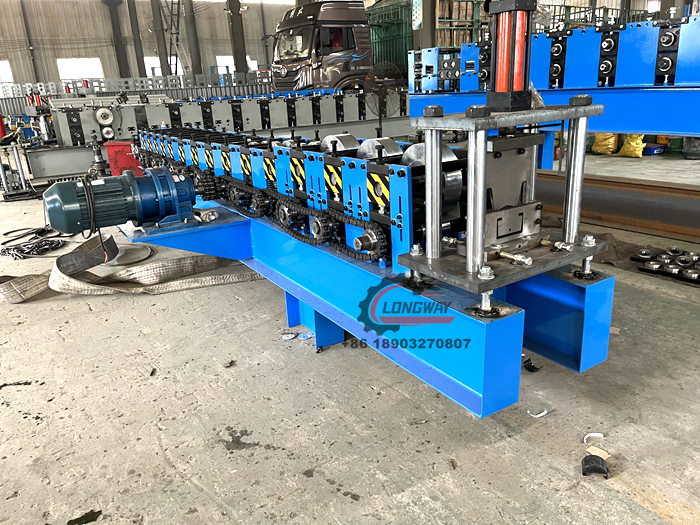Machine for Crimping Roof Sheets Efficiently and Precisely for Construction Projects
The Role of Roof Sheet Crimping Machines in Modern Construction
In the ever-evolving world of construction, the need for efficiency, precision, and durability has never been more prominent. One crucial component that contributes significantly to these requirements is the roof sheet crimping machine. This specialized equipment plays a vital role in the manufacturing process of roofing materials, ultimately impacting the quality and longevity of buildings.
Understanding Roof Sheet Crimping Machines
Roof sheet crimping machines are designed to create ribs and structural patterns in metal sheets, enhancing their strength and aesthetic appeal. These machines can process various materials, including steel, aluminum, and copper, which are commonly used in roofing applications. The primary function of a crimping machine is to form corrugated or ribbed patterns onto flat metal sheets, which increases the strength-to-weight ratio and improves water runoff, making the roofs more resilient to adverse weather conditions.
Advantages of Crimping Machines
There are several advantages to using roof sheet crimping machines in construction. Firstly, they significantly enhance the structural integrity of roofing materials. The ribbing produced by the machine adds stiffness and strength, providing better support and protection against environmental factors such as wind and rain. This is particularly important in regions prone to severe weather conditions, where traditional roofing may not withstand the forces of nature.
Secondly, crimping machines improve the thermal efficiency of roofs. The design of crimped sheets allows for better insulation, helping to keep buildings cooler in the summer and warmer in the winter. This energy efficiency is not only beneficial for the environment but also leads to substantial cost savings in heating and cooling expenses.
Moreover, crimping machines are associated with reduced waste and increased production speed. With advanced technology, these machines can produce high volumes of finished product in a relatively short amount of time. This efficiency not only accelerates construction timelines but also minimizes material waste, as the precision of the machine leads to less scrap production.
roof sheet crimping machine

Technological Advancements
The design and functionality of roof sheet crimping machines have evolved over the years. Modern machines are often equipped with digital controls, allowing operators to adjust settings for various sheet sizes, materials, and crimping patterns with ease. Automated features can further enhance production speed and consistency, ensuring that every batch of roofing material meets the required specifications.
Wireless communication technology is also making its way into crimping machines, allowing operators to monitor performance and maintenance needs remotely. This means that potential issues can be detected and addressed before they lead to downtime, resulting in a more efficient manufacturing process overall.
Applications in Construction
Roof sheet crimping machines are widely used in various sectors of construction, including residential, commercial, and industrial projects. They are integral to the production of metal roofs that are not only functional but also aesthetically pleasing. Architects and builders are increasingly opting for crimped metal roofs due to their modern look and versatility in design.
In addition to roofing, crimping machines are also used to fabricate siding, wall panels, and other architectural elements. The ability to produce different profiles and finishes allows for greater creativity in the design of buildings, contributing to the growing trend of innovative architectural solutions.
Conclusion
The roof sheet crimping machine is a vital tool in the modern construction industry, driving efficiency, enhancing durability, and minimizing waste. As technology continues to advance, crimping machines will become even more sophisticated, offering greater precision and automation. For builders and manufacturers, investing in a reliable crimping machine is not just a matter of keeping up with industry standards; it’s a strategic move that contributes to the sustainability and resilience of future construction projects. Embracing this technology can lead to improved quality in roofing solutions, ultimately resulting in safer and more efficient buildings for communities worldwide.
-
Roof Panel Machines: Buying Guide, Types, and PricingNewsJul.04, 2025
-
Purlin Machines: Types, Features, and Pricing GuideNewsJul.04, 2025
-
Metal Embossing Machines: Types, Applications, and Buying GuideNewsJul.04, 2025
-
Gutter Machines: Features, Types, and Cost BreakdownNewsJul.04, 2025
-
Cut to Length Line: Overview, Equipment, and Buying GuideNewsJul.04, 2025
-
Auto Stacker: Features, Applications, and Cost BreakdownNewsJul.04, 2025
-
Top Drywall Profile Machine Models for SaleNewsJun.05, 2025








